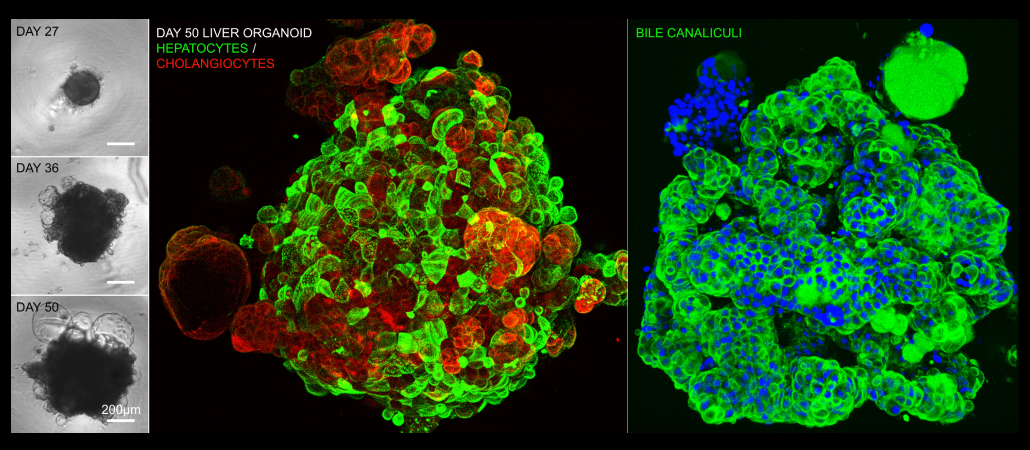A*STAR NEWS
PRESS RELEASES
Singapore Scientists Develop Advanced Human Liver Organoids
The liver organoids enable scientists to better understand how structural changes in the liver occur during liver injuries induced by drugs and non-alcoholic fatty liver disease (NAFLD)

Singapore scientists grow liver organoids in a dish that mimics the complex structural features of a human liver organ (Left brightfield images: Liver organoids developing over time in the dish. Right fluorescence images: Visualisation of different cell types and liver organ structures in the organoids) (Copyright: A*STAR’s Genome Institute of Singapore)
Singapore – A long-term research collaboration between A*STAR’s Genome Institute of Singapore (GIS) and the National University of Singapore (NUS) has successfully created first-in-class human liver organoids that capture both the functional and structural features of the organ. Notably, the advanced liver organoids are able to replicate structural changes that occur during liver injuries induced by drugs and non-alcoholic fatty liver disease (NAFLD). The research will help scientists to better understand liver biology and how liver diseases develop, and facilitate the development of novel therapies. The findings of this research were published online in the scientific journal Gastroenterology on 15 June 2020.
NAFLD is one of the most common causes of liver disease that affects up to one third of the adult Singapore population1, and more than a quarter of the global adult population2. It is characterised by the building up of fat in the livers of people who consume little to no alcohol, and is often associated with obesity and type 2 diabetes. There are currently no approved therapies for it, and the first-line treatment recommendations are dietary and lifestyle changes, due to the disease’s close association with obesity.
Research on new therapeutics for NAFLD has been hampered by the availability of a relevant human disease model. NAFLD is a chronic liver disorder with multiple cellular and structural pathophysiology which are not able to be fully recapitulated by existing human hepatocyte and mouse models. Scientists are in need of more advanced human cellular models that can capture both molecular and structural changes of the liver during disease progression.
To address this challenge, the research team developed advanced liver organoids using human stem cells. The liver organoids are able to replicate important NAFLD-induced disease pathophysiology in livers, and can be used to model other complex liver diseases. This will help scientists to better understand how NAFLD patients develop liver injuries and to devise better therapeutic strategies in the future.
Prof Ng Huck Hui, Senior Group Leader at GIS, said, “The increase in prevalence of liver disease and the lack of therapeutics place a huge burden on healthcare systems worldwide. There is a dire need to better understand liver biology in order to develop advanced cellular models of disease, and novel therapies.”
Dr Chan Yun Shen, Senior Programme Manager and lead senior author for this study, said, “Our discovery provides researchers in the field of hepatology with an advanced human cellular organoid model for the study of liver injuries that impair the bile transport system. Our organoids provide them with a new tool to discover therapeutics through in vitro drug testing and large-scale drug screening.”
Assoc Prof Dan Yock Young of NUS Yong Loo Lin School of Medicine, said, “Patients with early stage NAFLD remain largely asymptomatic, and the disease progresses silently over the years. What drives the disease progression and liver injury remains largely unknown. The development of advanced human liver models of the disease will provide a critical tool for researchers to identify molecular drivers of the disease.”
Prof Patrick Tan, Executive Director of GIS, said, “Human organoid culture technology has greatly improved scientists’ ability to model human organ development and disease pathogenesis in the last decade. Our study is a breakthrough for the liver organoid field and continues to advance this important field of research. Its success also signifies the importance of collaboration between clinician scientists and stem cell biologists to create first-in-class human organoid models for diseases.”
– END –
1 Aslam F, Kazimianec A, Banerjee R, Bryant JA, Chin CWL. (2019) Prevalence of NAFLD in a Singaporean cohort using non-invasive multiparametric MRI. Singapore Hepatology Conference, 7-8 June
About A*STAR's Genome Institute of Singapore (GIS)
The Genome Institute of Singapore (GIS) is an institute of the Agency for Science, Technology and Research (A*STAR). It has a global vision that seeks to use genomic sciences to achieve extraordinary improvements in human health and public prosperity. Established in 2000 as a centre for genomic discovery, the GIS will pursue the integration of technology, genetics and biology towards academic, economic and societal impact.
The key research areas at the GIS include Human Genetics, Infectious Diseases, Cancer Therapeutics and Stratified Oncology, Stem Cell and Regenerative Biology, Cancer Stem Cell Biology, Computational and Systems Biology, and Translational Research.
The genomics infrastructure at the GIS is utilised to train new scientific talent, to function as a bridge for academic and industrial research, and to explore scientific questions of high impact.
For more information about GIS, please visit https://www.a-star.edu.sg/gis.
About the Agency for Science, Technology and Research (A*STAR)
The Agency for Science, Technology and Research (A*STAR) is Singapore's lead public sector agency that spearheads economic oriented research to advance scientific discovery and develop innovative technology. Through open innovation- we collaborate with our partners in both the public and private sectors to benefit society.
As a Science and Technology Organisation- A*STAR bridges the gap between academia and industry. Our research creates economic growth and jobs for Singapore- and enhances lives by contributing to societal benefits such as improving outcomes in healthcare- urban living- and sustainability.
We play a key role in nurturing and developing a diversity of talent and leaders in our Agency and Research Institutes- the wider research community and industry. A*STAR oversees 18 biomedical sciences and physical sciences and engineering research entities primarily located in Biopolis and Fusionopolis. For ongoing news, visit www.a-star.edu.sg.
ANNEX A – NOTES TO EDITOR
The research findings described in this media release can be found in the scientific journal Gastroenterology, under the title, “Human Pluripotent Stem Cell-Derived Organoids as Models of Liver Disease” by Muhammad Nadzim Bin RAMLI1, Yee Siang LIM1, Chwee Tat KOE1, Deniz Demircioglu1, Weiquan TNG1, Kevin Andrew Uy GONZALES1,2, Cheng Peow TAN1, Iwona SZCZERBINSKA1, Hongqing LIANG1, Einsi Lynn SOE 1, Zhiping LU1, Chaiyaboot ARIYACHET1, Ka Man YU1, Shu Hui KOH1, Lai Ping YAW1, Nur Halisah Binte JUMAT3, John Soon Yew LIM 8,9, Graham WRIGHT8,9, Asim SHABBIR10, Yock Young DAN3,4,#, Huck-Hui NG1,5,6,7,#,Yun-Shen CHAN1,#.
- Stem Cell and Regenerative Biology, Genome Institute of Singapore, 60 Biopolis Street, Singapore 138672.
- Robin Chemers Neustein Laboratory of Mammalian Cell Biology and Development, The Rockefeller University, 1230 York Ave, New York City, New York, USA 10065.
- Department of Medicine, Yong Loo Lin School of Medicine, National University of Singapore, 10 Medical Dr, Singapore 117597
- Division of Gastroenterology and Hepatology, University Medicine Cluster, National University Hospital, 5 Lower Kent Ridge Road, Singapore 119074
- Department of Biochemistry, National University of Singapore, Singapore 117559, Singapore
- Dept of Biological Sciences, National University of Singapore, 14 Science Drive 4, Singapore 117597.
- School of Biological Sciences, Nanyang Technological University, 60 Nanyang Drive, Singapore 639798
- Institute of Medical Biology, A*STAR, Singapore, 138684, Singapore
- Skin Research Institute of Singapore, A*STAR, Singapore, 138648, Singapore.
10. Department of Surgery, University Surgical Cluster, National University Hospital, 5 Lower Kent Ridge Road, Singapore 119074
# Corresponding authors: Yock Young DAN (mdcdyy@nus.edu.sg), Huck-Hui NG (nghh@gis.a-star.edu.sg), Yun-Shen CHAN (chanysw@gis.a-star.edu.sg).
Was This Article Helpful?
A*STAR celebrates International Women's Day

From groundbreaking discoveries to cutting-edge research, our researchers are empowering the next generation of female science, technology, engineering and mathematics (STEM) leaders.
Get inspired by our #WomeninSTEM
